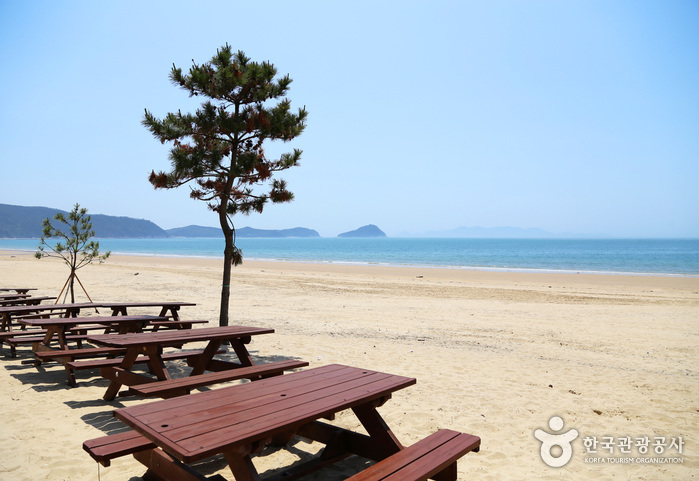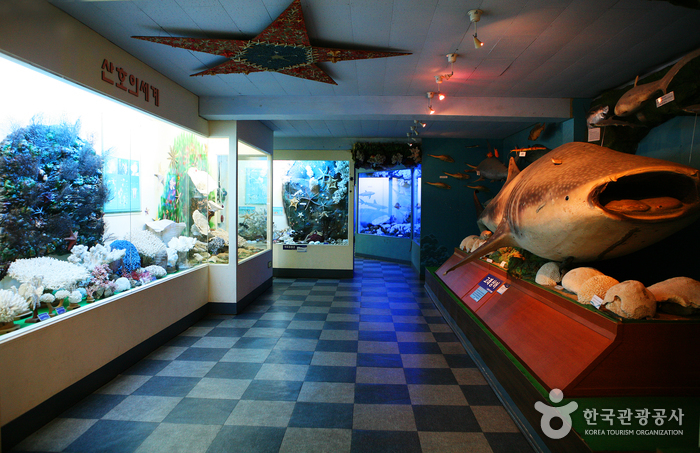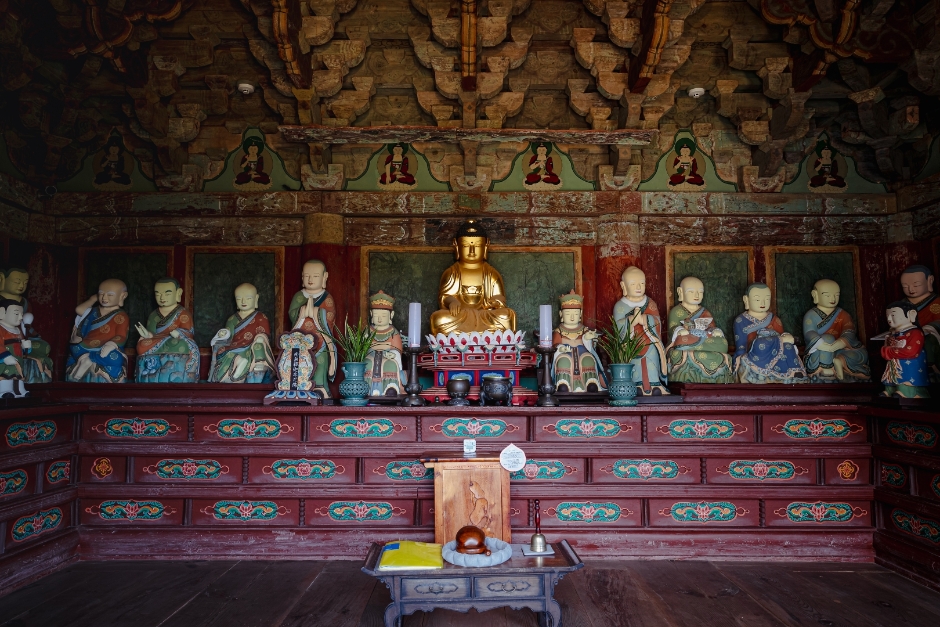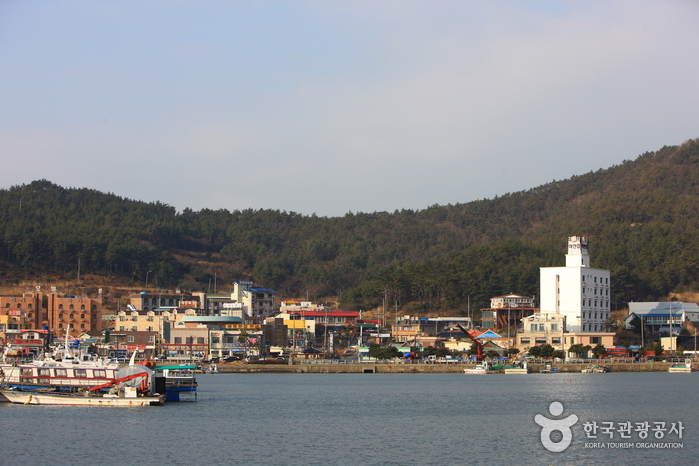Sinji Myeongsasimni Beach (신지 명사십리해수욕장)
10.7Km 2021-07-01
Sinji-myeon, Wando-gun, Jeollanam-do
+82-61-550-6921
Sinji Myeongsasimni Beach is located at the center of Dadohaehaesang National Park. The beach got its name from its singing sand, and the name can be literally translated to "sound of sand that can be heard from 4 kilometers away." The beach shore has a x_width of 150 meters and a length of 4 kilometers, covered with shimmering silver sand, and forms a gradual slope into the shallow water. The beach is not only popular for water activities, but also for its fine sand massage.
Wando Moraetteul (완도모래뜰)
10.7Km 2024-12-04
전라남도 완도군 신지면 명사십리길 74
061-552-4015
It is a restaurant where you can enjoy the “Haeyang Chiyu Bapsang” (marine healing set menu) developed by Wando-gun in 2021. “Haeyang Chiyu Bapsang” features Wando’s seafood, including abalone innards, hijiki, green sea fingers, kelp, and seaweed stems.
Ttangkkut Marine Natural History Museum (땅끝해양자연사박물관)
10.9Km 2021-02-22
5-4, Jungdaedong-gil, Haenam-gun, Jeollanam-do
+82-61-535-2110
The Ttangkkeut Marine History Museum houses approximately 25,000 specimens with 40,000 pieces on display including shellfish, coral, fish, mammals, crustaceans, fossils, reptiles, and insects from around the world, making it the most diverse collection of items in the southern region. Visitors can take part in ecological activities to learn more about phenomenal and rare marine resources and cultures.
Wando Marine Healing Center (완도해양치유센터)
11.8Km 2025-10-23
100 Haeyangchiyu-gil, Sinji-myeon, Wando-gun, Jeollanam-do
+82-61-550-7675~6
Wando Marine Healing Center is the first marine therapy facility in Korea. It has 16 types of therapy facilities utilizing seawater, mud, and marine algae. There are five programs on the first floor, such as the Thalasso Pool, Mud Therapy, Marine Algae Bubble Therapy, and the Seawater Mist. On the second floor, the center runs wet therapy programs (steam shower, marine algae bath, wet therapy using seawater) and dry therapy programs themed around stimulating the five senses using colors, sound, music, scents, and stones.
Mihwangsa Temple (미황사)
12.9Km 2025-10-23
164 Mihwangsa-gil, Haenam-gun, Jeollanam-do
+82-61-533-3521
Constructed during the eighth year of King Gyeongdeok of the Silla dynasty (749), Mihwangsa Temple is located on the western side of Dalmasan Mountain (489 meters), titled the Geumgangsan Mountain of the Southern Sea. The temple is situated the furthest south of all temples in the Korean peninsula. Beautiful sunsets and the view of the graceful Dalmasan Mountain from the temple attract numerous visitors. The foot of the mountain found behind the temple blends well with the suitable-sized temple and the appearance of Daeungbojeon Hall gives out an aura of comfort and tranquility. The cornerstone of Daeungbojeon Hall is carved with sea creatures, such as turtles and crabs that cannot be observed elsewhere. Other attractions include 18th century murals on the walls of Daeungbojeon and Unginjeon Halls.
Galdu Village (Ttangkkeut Village) (갈두마을 (땅끝마을))
14.2Km 2025-03-16
82, Ttangkkeunmaeul-gil, Haenam-gun, Jeollanam-do
+82-61-532-3883
Galdu Village, also referred to as Ttangkkeut (Land's-end) Village in Haenam-gun, Jeollanam-do is at the southernmost point of the Korean peninsula. The island has an observatory at Sajabong Peak, where one can get an unobstructed view of the southern archipelago, and even a glimpse of Hallsan Mountain on Jeju Island on a clear day. The name "galdu" originated from the Chinese characters for arrowroot, which was commonly found in the nearby mountains.
Ttangkkeut Observatory (땅끝전망대)
14.6Km 2025-02-03
100 Ttangkkeunmaeul-gil, Songji-myeon, Haenam-gun, Jeollanam-do
The edge of the Haenam is referred to as ttangkkeut, which literally means at the end of the land. Located on Galdusan Mountain, the Ttangkkeut Observatory provides a panoramic view spanning from Jindo Island to Wando Island. The first floor of the observatory features a photo booth, where visitors can take pictures with Haenam’s Mascot and Ttangkkeut Village in the background. The café on the first floor provides visitors an opportunity to rest. Even though the observatory is easily accessible by walk, it is recommended to take the monorail, which offers a beautiful view of the Ttangkkeut Village.
Ttangkkeut Tower & Skywalk (땅끝탑 스카이워크)
14.7Km 2025-02-03
Songho-ri, Songji-myeon, Haenam-gun, Jeollanam-do
Ttangkkeut Tower is a triangle monument commemorating the southernmost tip of the Korean peninsula. The Skywalk was remodeled using glass material with the theme of “taking one step beyond the end of the land,” symbolizing the end the beginning of the Korean peninsula. The skywalk made with transparent glass panels, offers visitors the thrill of walking above the sea. The installed photo booth provides visitors a chance to click great pictures with the vast blue sea in the background on one side and the Ttangkkeut Tower on another. It is also renowned for stunning sunset views.
Ttangkkeut Monorail (땅끝모노레일)
14.7Km 2024-02-20
60-28 Ttangkkeunmaeul-gil, Songji-myeon, Haenam-gun, Jeollanam-do
Ttangkkeut Monorail is a tourist monorail that runs to the Ttangkkeut Village Observatory. It takes about 6 minutes for a one-way trip to the observatory, during which passengers can enjoy the beautiful scenery of Ttangkkeut Village in Haenam, stretching from the mountains to the sea. After enjoying the view from the top, visitors can descend via stairs to reach the Ttangkkeut Tower.
Dadohaehaesang National Park (Wando Section) (다도해해상국립공원(완도))
14.8Km 2024-04-04
Wando-eup, Wando-gun, Jeollanam-do
+82-61-550-0900
Dadohaehaesang National Park was established on December 23, 1981 as the 14th national park, and it is the nation's largest park, spread over 2,344 ㎢. Within this area are nearly 1,700 islands of varying sizes, including Hongdo, Heuksando, Geomundo, and Baekdo Islands. During the Silla period, the King of the Sea, Jang Bogo established the maritime world and during the Goryeo dynasty, the area was a trading path with the Yuan and Song dynasties. Also, it was the battlefield where Admiral Yi Sun-sin defeated the invading navy during the Imjin War (1592-1598). Likewise, historical sites remain in many places.






 English
English
 한국어
한국어 日本語
日本語 中文(简体)
中文(简体) Deutsch
Deutsch Français
Français Español
Español Русский
Русский